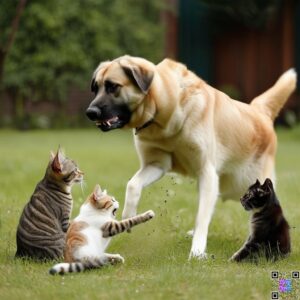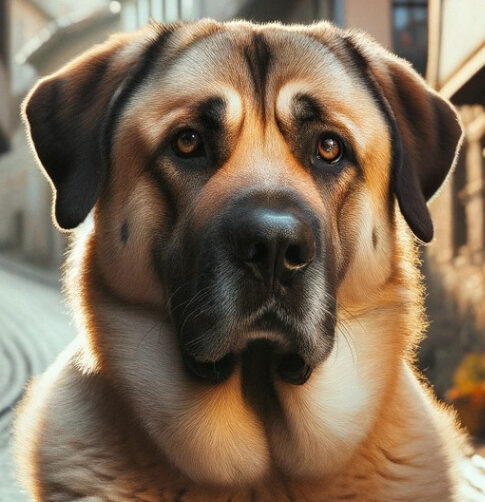Introduction
The Anatolian Shepherd with cats is a topic that sparks curiosity among pet owners and animal lovers alike. These majestic dogs, known for their guarding instincts and loyalty, often raise questions about their compatibility with feline friends. The Anatolian Shepherd is a breed that has been revered for centuries, primarily for its role as a livestock guardian. However, as more people adopt these dogs into their families, understanding how they interact with other pets, particularly cats, becomes essential. This article delves into the characteristics of the Anatolian Shepherd, their behavior towards cats, and tips for ensuring a harmonious household.
Understanding the Anatolian Shepherd


The Anatolian Shepherd is a large, powerful dog breed originating from Turkey, specifically the region of Anatolia. These dogs were bred to protect livestock from predators, making them independent and strong-willed. Their physical traits include a muscular build, a broad head, and a thick coat that can come in various colors. Typically, males weigh between 110 to 150 pounds, while females range from 80 to 120 pounds. Their temperament is equally noteworthy; Anatolian Shepherds are known for being loyal, alert, and protective. They often form strong bonds with their families but can be wary of strangers. This protective nature makes them excellent guardians, but it also means that early socialization is crucial. Without proper exposure to various animals and environments, they may become overly territorial or aggressive.
Anatolian Shepherd with Cats
When it comes to the Anatolian Shepherd with cats, the relationship can vary significantly based on individual experiences and training. Many Anatolian Shepherds can coexist peacefully with cats, especially if they are introduced at a young age. These dogs often view cats as part of their flock, which can lead to protective behavior rather than aggression. Socialization plays a vital role in shaping how an Anatolian interacts with cats. Early exposure to cats can help the dog learn to respect their space and understand their behavior. Owners who have successfully integrated Anatolian Shepherds with cats often report positive experiences, noting that their dogs can be gentle and playful with their feline companions. However, it’s essential to monitor interactions closely, particularly during the initial introductions.
Training an Anatolian Shepherd for Coexistence
Training an Anatolian Shepherd to accept cats involves consistent and positive reinforcement methods. Start with basic commands such as “sit,” “stay,” and “leave it.” These commands can be invaluable when managing interactions between the dog and the cat. Socialization should begin as early as possible. Expose your Anatolian to various animals, including cats, in a controlled environment. This exposure helps the dog learn appropriate behaviors and reduces the likelihood of aggressive tendencies. It’s also crucial to manage the dog’s territorial instincts, as Anatolian Shepherds can be protective of their home. Using treats and praise can reinforce positive behavior when the dog remains calm around the cat. If the dog shows signs of aggression or overexcitement, redirect their attention to a toy or command them to perform a different task.
Creating a Safe Environment for Cats and Dogs
To ensure a peaceful coexistence between an Anatolian Shepherd and cats, creating a safe environment is essential. Start by designating separate spaces for each pet, allowing them to retreat when they need their own space. Supervision is critical during initial interactions. Always monitor their behavior, especially if the dog is still learning to accept the cat. Gradually increase the time they spend together as they become more comfortable with each other. Providing safe zones for the cat, such as high perches or separate rooms, can help them feel secure. This setup allows the cat to escape if they feel threatened, reducing stress for both animals.
Health Considerations for Anatolian Shepherds
Like all breeds, Anatolian Shepherds are prone to certain health issues. Common concerns include hip dysplasia, obesity, and certain genetic conditions. Regular veterinary check-ups are essential to monitor their health and catch any potential issues early. Preventative care is crucial for maintaining the health of your Anatolian Shepherd. Ensure they receive a balanced diet, regular exercise, and proper grooming. Keeping their weight in check is particularly important, as obesity can lead to various health problems.
Anatolian Shepherds and Their Unique Bond with Cats
Anatolian Shepherds possess natural instincts that make them excellent guardians not just for livestock but also for household pets like cats. Their protective nature means they often see cats as part of their family unit. This bond can lead to unique interactions where both species learn to communicate effectively, establishing a peaceful coexistence.
Amazing Fact One: The Guardian Instinct
One of the most fascinating aspects of the Anatolian Shepherd is its guardian instinct. Historically used to protect sheep from wolves and other threats, this instinct extends to household pets. When living alongside cats, an Anatolian will often take on a protective role, ensuring their feline friends feel safe. This behavior can create a strong bond where both animals look out for each other.
Amazing Fact Two: Size and Strength
Anatolian Shepherds are large dogs, often weighing between 90 to 150 pounds. In contrast, domestic cats typically weigh between 5 to 20 pounds. This size difference plays a significant role in how these animals interact. While an Anatolian’s strength can be intimidating, it also means they can provide a sense of security for smaller pets like cats. Owners often find that this dynamic fosters a protective environment where both animals thrive.
Amazing Fact Three: Intelligence and Trainability
Known for their intelligence, Anatolian Shepherds are quick learners but can also be independent thinkers. This trait makes training essential when introducing them to cats. Positive reinforcement techniques work best; rewarding desired behaviors helps establish boundaries and encourages friendly interactions between the two species. Owners who invest time in training will likely see their dogs develop respectful relationships with their feline companions.
Amazing Fact Four: Adaptability to Various Environments
Anatolian Shepherds are incredibly adaptable dogs. They can thrive in rural settings as well as urban environments, provided they receive adequate exercise and mental stimulation. This adaptability extends to living with cats; whether in a spacious home or a cozy apartment, these dogs can adjust their behavior to coexist peacefully with felines.
Amazing Fact Five: Health Benefits for Both Dogs and Cats
Having an Anatolian Shepherd around can provide numerous health benefits for both dogs and cats. The companionship fosters emotional well-being; studies have shown that pets reduce stress levels in humans as well as other animals. Moreover, engaging in playtime encourages physical activity, which is vital for maintaining a healthy weight in both species.
Amazing Fact Six: Unique Communication Styles
Understanding body language is crucial when observing interactions between an Anatolian Shepherd and a cat. These dogs communicate through various vocalizations—barks, growls, or whines—that convey different messages. Similarly, cats have their own set of signals such as tail positioning or ear movements that indicate their feelings. By learning these cues, owners can facilitate better communication between their pets.
Amazing Fact Seven: Lifespan and Care Needs
The average lifespan of an Anatolian Shepherd ranges from 10 to 13 years. Proper care is essential to ensure they live long, healthy lives alongside their feline friends. Regular veterinary check-ups, balanced diets, exercise routines tailored to both species’ needs, and mental stimulation through play are crucial components of care that benefit both animals.

FAQs
1- Do Anatolian Shepherds get along with cats?
Yes, many Anatolian Shepherds can get along well with cats, especially if they are socialized together from a young age.
2- What should I do if my Anatolian is aggressive towards cats?
If your Anatolian shows aggression towards cats, it’s important to seek professional training and work on socialization techniques.
3- How can I train my Anatolian to accept cats?
Start with basic commands and gradually introduce your Anatolian to cats in a controlled environment, using positive reinforcement.
4- Are Anatolian Shepherds good family pets?
Yes, they can be excellent family pets, particularly for families who understand their needs and provide proper training.
5- What is the best way to introduce an Anatolian to a cat?
Introduce them gradually, allowing them to observe each other from a distance before allowing closer interactions.
6- How much exercise does an Anatolian Shepherd need?
Anatolian Shepherds require at least an hour of exercise daily, including walks, playtime, and mental stimulation.
Conclusion
The Anatolian Shepherd with cats can be a rewarding relationship when approached with care and understanding. By focusing on proper training, socialization, and creating a safe environment, pet owners can foster a harmonious coexistence between these magnificent dogs and their feline friends. With patience and love, the bond between an Anatolian Shepherd and a cat can flourish, enriching the lives of both pets and their families.
